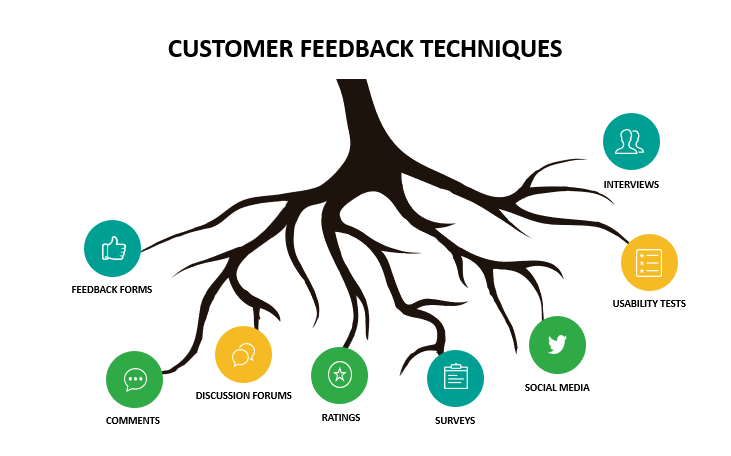
Today, consumers call the shots. With globalization and the internet providing nearly unlimited choices, power has shifted from corporations to consumers. This shift makes it nearly impossible for companies to sustain differentiation based solely on price or product. The only option that remains is the customer experience. Every business organization tries its best to please customers, satisfy their needs, and eventually keep them loyal to your brand. But how can you be sure that your efforts bring desired results? Their opinions about the experience they have with your brand are helpful information that you can use to adjust your business to fit their needs more accurately.

Customer feedback is the information provided by your customers about whether they are satisfied or dissatisfied with a product or service and the experience they had with a company. Their opinion is a resource for improving customer experience and adjusting your actions to their needs. Top performing companies understand an important role customer feedback plays in business. They consistently listen to the voice of their clients. To stay ahead of the competition an enterprise never stops listening to customer feedback whether it is positive or negative, prompted or unprompted.
Gathering customer feedback is very important for your customer support strategy, as is staying in touch with your customers at every step of their journey with your brand. Customer feedback is crucial in managing customer satisfaction and loyalty, customer retention, improving products and services, and in many more areas of your business.
Customer feedback is an insight into what is working well about your product or service and what should be done to make the experience better. The theoretical industry expertise can never be more valuable to business performance than customer insights. Their opinions help you ensure that the end product will actually meet their expectations, solve their problems and fulfill their needs.
A business may have a high sales volume, but it can retain sales volumes only if customers are repeat buyers. Detailed customer satisfaction surveys that will measure how customers connect with your wares, and their willingness to become repeat buyers. Satisfaction-measurement surveys can be conducted by sharing a survey link via email or through SMS broadcasts. These surveys should be built with rating-based questions to track how happy (or unhappy) your buyers are, and what you can do to improve their experience.
Good customer feedback data can generate personal recommendations from your best customers. When you ask for their opinions, your customers feel involved with the growth of your business and feel they are valued and are then more likely to promote your business with their positive personal recommendations.
A satisfied customer will stay with you. An unhappy customer will eventually find a better alternative to your business and leave. Customer feedback helps you determine if your clients are satisfied with your service and detect areas where you should improve. If a dissatisfied customer expresses his disappointment you can immediately react and find a solution to fix an issue. This way you can win a client back and even increase his level of loyalty. An unhappy customer who encountered a problem with your service, but you got it fixed straightaway demonstrates bigger devotion to your brand.
Feedback is a great tool to help your support team analyze and improve their performance. Sharing customer feedback data with support managers will help them to understand how your brand’s service and support functions are performing. The support staff is at the forefront of your consumer-facing communications, so sharing feedback with them is essential. It will motivate them to hustle and interact gently, and your business only stands to gain. A good way to stay in contact with your customers is by employing a feedback strategy on your website knowledge base.
Customer feedback can be used to make better business decisions, as well as identify brand advocates to improve future marketing research and strategies. Businesses burn money and time when they make decisions based on inaccurate data. True data insights show how customers perceive the business and its products. This feedback should become the guide for better marketing decisions.
There are three primary types of customer feedback channels: direct, indirect, and inferred.
Customer feedback has become one of the primary drivers of long-term growth. Present-day organizations jump at every opportunity to talk to the customer or learn about them. Businesses are spending millions of dollars on setting up feedback channels: emails, reviews, surveys, website analytics.
Customer feedback has gradually become the cornerstone of growth initiatives. Customer feedback helps to keep customers from churning and gives them a feeling of involvement, hence build customer loyalty.
There is no one-size-fits-all tactic to gain information from your users. Different situations require different methods of collecting customer feedback. For example, a survey form sent to an already angry user will only make matters worse; a phone call works better here. Therefore, first, determine the reason for user feedback; is it first-hand advice on product improvement or feedback required for building a new feature? Below are the techniques used for customer feedback.

A feedback form allows you to get a pulse on how your customers feel about your brand, products, and customer support. Your customers are constantly thinking of ways that your business could be better. Maybe parts of your site don’t quite give them what they’re looking for. More often than not, they won’t reach out to your support team. But for the minor annoyances and issues, your customer will just give up and walk away slightly frustrated. Surveys might catch the problem if you ask a related question at the right time. When minor issues pop up too frequently, customers will start shopping around for a better solution. To get customers to tell us about the small things, a business can use a feedback form. At the bottom of every page, you can ask the users to post a box-like how can we improve on it.
A comment box would allow users to quickly submit a comment or problem straight to the website. Comment sections are a great opportunity for you to foster a personal relationship with your users. Digitally savvy users that are interacting with your content are now doing so from mobile devices more than half of the time. And mobile users love the sense of participation. If you can engage your user on a personal level and not only welcome comments/reviews but encourage them, it will do three things.
This type of feedback mechanism is suitable to generate new ideas or explore the underlying issues driving customer sentiment, the use of focus groups and discussion forums can be a way to leverage the synergy value of customers interacting with each other. Discussion groups can be an effective brainstorming technique, moving beyond collecting feedback on past events to capture input and feedback on potential changes you are considering for the future. Gaining customer feedback through discussion groups can enable you to predict how well something new would be received and identify potential issues so they can be mitigated.
Customers generally get frustrated when bombarded with long questionnaires. It is better to offer them a review method that is instant such as a 5-star rating or yes/no plugin which takes a few seconds of the user but has a high impact. This way of feedback is not only important for customers as they feel connected but also lets other customers decide about your product based on their ratings. For instance, customers usually prefer products with higher ratings on e-commerce sites.
Contact forms are an excellent way to capture customer feedback from website visitors. Primarily used by customers to submit questions or report issues, contact forms help companies easily gather open-ended feedback.
The survey gives you the opportunity to ask several questions from customers at one time. There are two kinds of surveys from which you can choose; short slider surveys that pop up on your site or longer, traditional surveys.
These are intended to provide just enough simple and prompt feedback to tell you whether your attempts to improve are going in the right direction. These are one-question surveys that you can launch for your visitors (customers who are already active on your website) to gauge the response.
Customer satisfaction surveys are an important tool used to gather feedback from customers about their satisfaction levels, and for developing strategies for improvement. However, make sure to not make these surveys too long that your users get frustrated than feeling valued. Several free platforms are available that you can use to explore the power of feedback.
For usability testing to bring deep insights to your company, requires more upfront planning. With a clear strategy, though, you can uncover challenges that customers don’t know they’re facing and actionable insights that make their experiences better. When you are 90% finished with the updates, these tests guarantee to get that last 10% right.
Even though user testing is associated with web-based products, the fundamentals apply to any business. For instance, if you are a dance teacher, offer your customer, free demo classes of a week, before joining and let them share their experiences. If you are a software solution provider, offer them a free trial of your software for some time and ask for their feedback. Learning about the business from their perspective uncovers small tweaks that make a huge difference to the customer experience.
Reaching out to customers directly opens up conversations that otherwise wouldn’t happen. Interviews are qualitative customer satisfaction measures and let you go through the real experience of customers. These personal experiences help a team understand the feelings behind customer decisions and the community respond to a company’s brand or decisions. When you conduct customer interviews, you create the opportunity to challenge false assumptions that developed over time. Tips for conducting interviews:
Social listening can give you access to an otherwise untapped reservoir of candid feedback from customers. Incorporate customer engagement into your social media plan. Make sure your social media plan sets aside time for live interaction with users and monitors social media mentions so they can be acknowledged promptly to help your business shine in front of prospects. Show those users just how well you take care of your existing customers and watch how quickly they can expand awareness for your business through word of mouth. Recognizing problems and resolving them will give credibility to your business.
One of the ways you can gain valuable customer feedback is by monitoring mentions of your brand on social media. When you see your company’s name being talked about, you can reach out to the people who mentioned it and ask about their experience. This allows you to develop a proactive approach that clients love because they feel that they’re genuinely being taken care of.
Analytics reveal what customers don’t know about how they use your product. Especially if you sell a digital product or service, you benefit from leveraging analytics to understand how users interact with your company. For example, if you offer self-service content as a form of customer service via a support knowledge base, you could see the number of people visiting each knowledge base article. Reporting tools available in the knowledge base software like PHPKB offer statistics that give you insights about failed searches, most frequently visited pages, and so on so you can improve your customer’s self-service experience.
Article ID: 206
Created: June 3, 2020
Last Updated: September 23, 2021
Author: Rinky Batra [rinky@phpkb.com]
Online URL: https://www.phpkb.com/kb/article/how-feedback-can-help-you-better-understand-your-customers-206.html